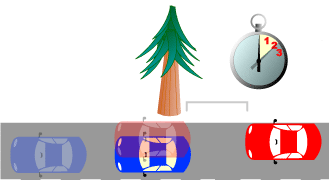Defensive driving

The standard Safe Practices for Motor Vehicle Operations, ANSI/ASSE Z15.1, defines defensive driving skills as "driving to save lives, time, and money, in spite of the conditions around you and the actions of others."[1] This definition is taken from the National Safety Council's Defensive Driving Course. It is a form of training for motor vehicle drivers that goes beyond mastery of the rules of the road and the basic mechanics of driving. Its aim is to reduce the risk of collision by anticipating dangerous situations, despite adverse conditions or the mistakes of others. This can be achieved through adherence to a variety of general guidelines, such as following the assured clear distance ahead and two second rules, as well as the practice of specific driving techniques. Some motorists describe defensive driving as, "driving as if everyone else on the road was drunk."
History
A driver safety program called the Driver Example Program was developed in 1964 by Chris Imhoff of the (US) National Safety Council.[2] The program instituted a Defensive Driving Course (DDC). Defensive Driving Courses, along with Instructor Development Courses were offered beginning 1964 and 1965, typically through corporate sponsorships.
General principles
Driving defensively includes:
- General principles:
- Controlling your speed.
- Looking ahead and expecting the unexpected.
- Being alert and distraction free.
- Regarding other participants in traffic:
- Preparedness for all sorts of actions and reactions of other drivers and pedestrians.
- Not expecting the other drivers to do what you would ordinarily do.
- Watching and respecting other drivers.
- Regarding your own vehicle:
- Maintaining a safe following distance.
- Driving safely considering (adjusting for) weather and/or road conditions.
- Adjusting your speed before entering a bend, in order to avoid applying the brakes in the middle of a bend.
Training and courses
Several government agencies, non profit organizations, and private schools have launched specialty courses that improve the public's driving skills. In the United States a few of the familiar courses in defensive driving include Alive at 25, DDC or Defensive Driving Course, Coaching the Mature Driver, Attitudinal Dynamics of Driving, Professional Truck Driving, and DDC for Instructors. In relation to this, the government has launched active Air Bag and seat Belt safety campaigns that encourage High Visibility Enforcement.
In addition to improving one's own driving skills, many U.S. states provide an incentive to complete an approved defensive driving course by offering mandated insurance discounts or a way to mask a traffic ticket from one's driving record. In some instances these courses are referred to as traffic school or a defensive driving school. States with the biggest incentives include Arizona, California, Florida, Nevada, New Jersey, New York, and Texas. A number of private providers offer a variety of courses. The methods and styles of the courses vary.
See also
References
- ↑ American National Standard Safe Practices for Motor Vehicle Operation, American Society of Safety Engineers, Des Plaines, IL, 2006
- ↑ http://www.nsc.org/safety_road/Defensive%20Driving%20Information%20Highway/Defensive_Driving_Resources/Pages/DefensiveDrivingCoursesHistoryTimeline.aspx, National Safety Council Defensive Driving Courses History Timeline